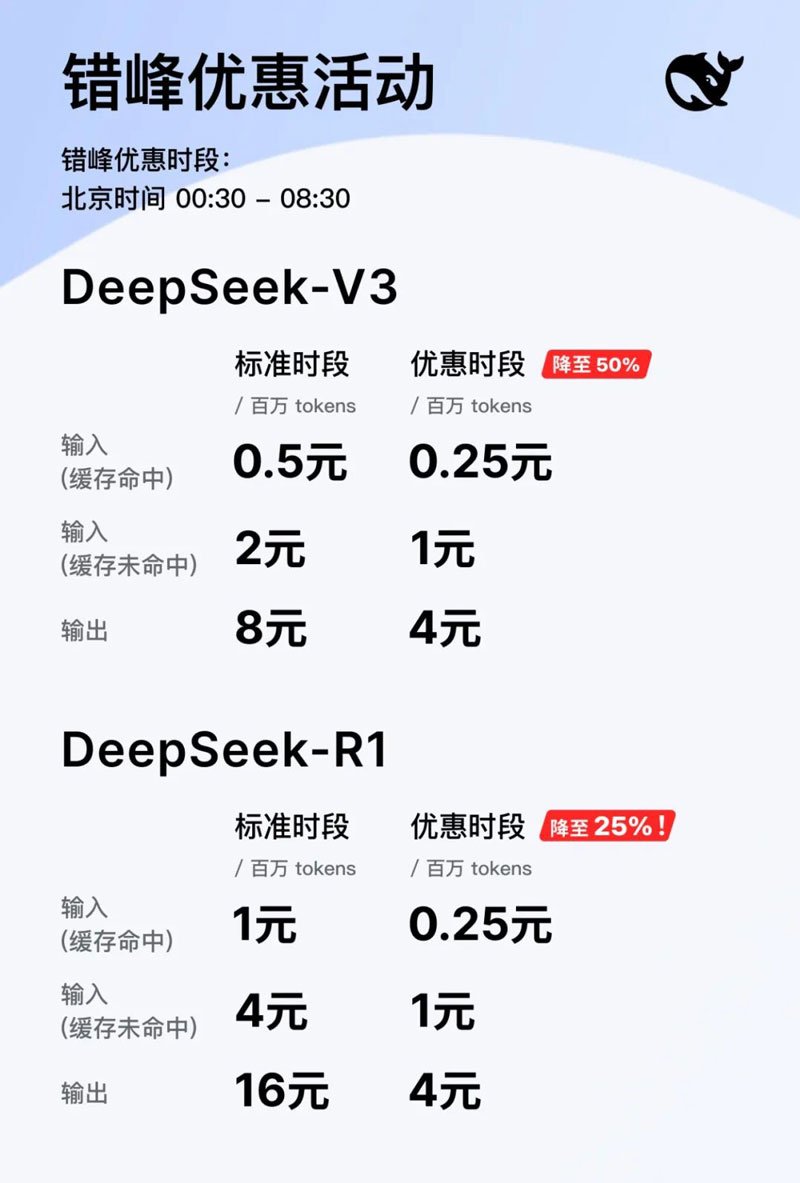In order to deal with the prominent problems of "peak congestion during the day and waste of resources at night”,DeepSeek's open platform launched the wrong peak promotion。 Users can use the wrong peak Token. During the free night time period from 00:30 to 08:30 Beijing time every day, the API call price will be significantly reduced: DeepSeek-V3 will be reduced to 50% of the original price, and DeepSeek-R1 will be reduced to 25%. DeepSeek encourages users to make full use of this period to enjoy a more economical and smoother service experience.

The reason why DeepSeek launched the night peak discount measure
According to statistics, the average night-time vacancy rate of China's data centers exceeds 60%, while the GPU utilization rate during peak daytime hours can reach more than 90%. Migrating 20%-30% of non-real-time tasks to night through peak price leverage can increase the overall utilization rate of server clusters from 45% to more than 65%, which is close to the operating level of leading vendors such as AWS.
The preferential strategy during the night time period can delay the hardware expansion pressure. Assuming that a cluster needs to support 1 million QPS (queries per second) during the day, after the peak-to-peak diversion, the actual hardware investment can be reduced by 15%-20%, which is equivalent to extending the procurement cycle of 100 servers by 6-8 months.
The night-time electricity price of data centers is usually 30%-50% of the daytime (for example, Beijing commercial electricity is 0.35 yuan/kwh in the night valley vs. 1.2 yuan/kwh in the daytime peak). By transferring the computing power load to the low-price period, the monthly electricity bill of a single cabinet can be reduced from 32,000 yuan to 18,000 yuan, and the positive revenue can still be maintained after combining with preferential pricing.
The essence of the night discount is to activate silent assets through marginal cost pricing (the marginal cost of night calls is close to 0). In theory, every 1% increase in night utilization can bring about a net income of about 2 million yuan/year (calculated according to the Wanka cluster).
Data show that 47% of global AI developers can accept delays of more than 6 hours for tasks, and this kind of demand constitutes a potential market of about 28 billion US dollars/year. The wrong peak strategy can attract users with high tolerance but price sensitivity, and cultivate users' flexible computing power consumption habits. Referring to the development path of AWS Spot Instance, after 2-3 years of implementation of such strategies, user stickiness is expected to increase by 40% and the paid conversion rate by 25%.
The benefits of the night peak discount to users
1. Significant cost savings
For small and medium-sized developers/enterprises, the night price of V3 is reduced to 50% and R1 is as low as 25%, which can significantly reduce the cost of AI application development. For non-real-time tasks such as batch processing of data and model training, the cost of a single task can be reduced by up to 75%, which is especially beneficial to start-up teams and individual developers.
Through 7-30 days of user behavior analysis, about 45% of batch processing requirements can be successfully migrated to the cloud. For example, an e-commerce data analysis team adjusted the daily product recommendation model training of 200,000 times to the early morning, and the monthly computing power cost was reduced from 12,000 to 3,200.
2. Service quality improvement
Competition for network bandwidth is reduced at night, and the inference speed obtained by users may be increased by 30%-50% with the same computing resources. If an NLP processing task requires 200ms/request during the day, it may be shortened to 120ms at night, which will significantly improve the efficiency of batch operations such as data cleaning.
The wrong peak discount has created a win-win technological and economic model of supply and demand: users get the cost optimization of real money, and the platform realizes a leap in resource efficiency. This kind of refined operation based on the time dimension will redefine the value distribution logic of cloud computing services. With the development of flexible computing power consumption habits, it may lead to industry-level price strategy changes.


Comment List (0):
Load More Comments Loading. . .